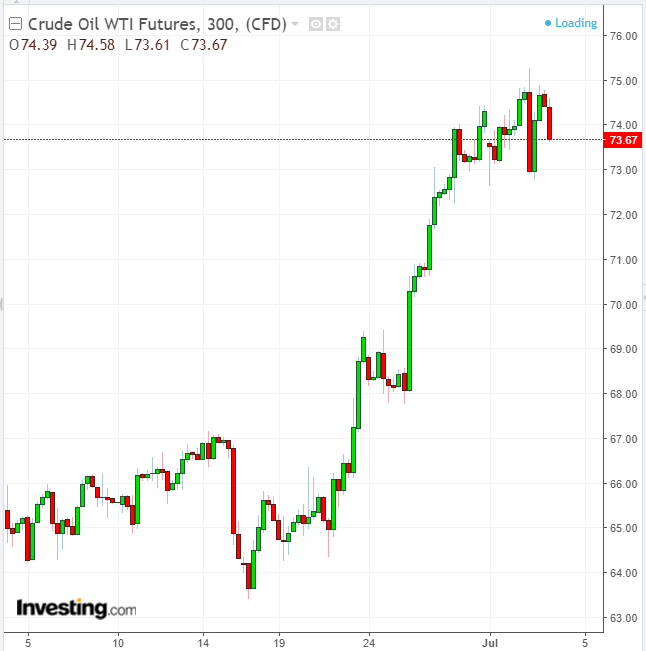U.S. equity markets are closed for today's 4th of July holiday, and trade, including in the oil markets, may be slow on lower volume for the remainder of the week. Nevertheless, oil prices have been on the move. Though the commodity is trading lower at the time of writing, oil hit $75 yesterday, for the first time since November, 2014.

Because of the holiday, the EIA inventory information will be released on Thursday instead of Wednesday. The forecasts all predict that the EIA crude numbers will show a draw in crude oil inventories. The question is how significant—TankerTrankers.com forecasts a draw of 9.8 million barrels.
The API expects a draw of 4.5 million barrels. However, the decrease in U.S. crude oil stocks is not the only issue affecting oil prices this week, a number of fundamental drivers are currently propelling crude prices.
1. U.S. Policy Toward Iran
Last week, the State Department announced that unlike during the Obama administration—which offered waivers to Asian importers of Iranian oil—the Trump administration would not be offering any such deals. Oil prices increased last week on the news that as much as 2.5 million barrels per day of Iranian oil could come off the market by November.
This past Tuesday, however, the State Department softened its approach and said that though its goal is still to reduce Iranian oil revenues to zero, it would be willing to “work with countries that are reducing their imports on a case-by-case basis.” Even though the media portrayed this as a significant policy shift, in practice it may be that the United States will only relax sanctions for China in exchange for concessions in the ongoing trade negotiations between the two countries.
India, the second largest importer of Iranian crude, does not seem to expect any special treatment and says it already has alternative sources of crude oil with which to replace the high-sulfur crude it imports from Iran.
2. Saudi Spare Capacity
On Saturday, President Trump ruffled feathers when he tweeted that he had discussed oil policy with the Saudi king and that Saudi Arabia agreed to increase production by 2 million barrels to prevent oil prices from moving too high. Saudi Arabia immediately issued a counter statement indicating it had made no such pledge.
Later, the White House clarified that King Salman affirmed that Saudi Arabia does have 2 million barrels per day of spare capacity and would be willing to employ what is necessary, in coordination with other OPEC and non-OPEC producers, to stabilize the market. The UAE has asserted that it is prepared to increase oil production in coordination with fellow producers Saudi Arabia and Russia.
3. Saudi Arabia and Russia
June production figures from Saudi Arabia and Russia indicate that both countries increased oil production last month. According to Reuters, Saudi Arabia raised output by 700,000 barrels per day to 10.7 million barrels; Russian production increased just slightly, to 11.06 million barrels per day as well.
Russia plans to increase its production by 200,000 barrels per day in the second half of 2018, while Saudi Arabia has not indicated specific amounts in comments about future increases. However, Saudi Arabia and Russia have engaged in preliminary conversations about changing the way oil production for members of the OPEC and non-OPEC production deal is monitored. This, they believe, will facilitate the group’s commitment to increasing production by at least 1 million barrels per day.
4. Outages Persist
Despite OPEC and Russian efforts to increase oil production, the drop in output from Venezuela, Canada and Libya continues to weigh on the market. The Libyan outage alone could take as much as 850,000 barrels per day for the market for an unknown time frame. Venezuela’s July production is expected to fall below the 1.36 million barrels it produced in May and Canada does not expect that Syncrude’s 360,000 barrels per day will return until the end of July.
Wishing all my American readers a happy Independence Day!
